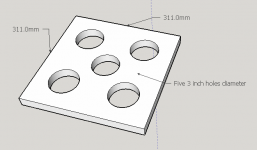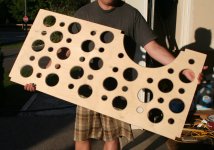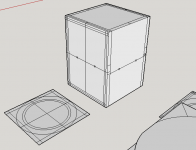Hello guys. What do you think about this bracing that I just designed? it's supposed to be located just at the center of a rectangle enclosure. I liked so much the aesthetics of this piece, but not sure how technically convenient it could be.
The sealed enclosure is 1.5 cubic foot for 12" subwoofer, and 1" mdf thick.
So we have here 5 holes, each one with a diameter of 3". I will round and smooth the edges using a router.
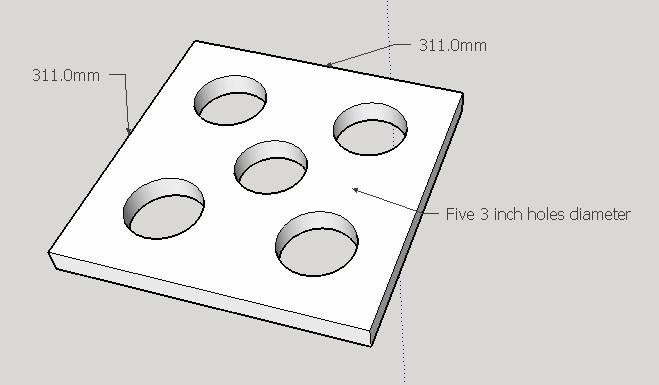
The sealed enclosure is 1.5 cubic foot for 12" subwoofer, and 1" mdf thick.
So we have here 5 holes, each one with a diameter of 3". I will round and smooth the edges using a router.
Attachments
Last edited:
The combined area of the holes is too small, it might impede airflow. The center hole weakens the 'ribs' that connect the walls to eachother, so the bracing will not provide maximum stiffness. Using four larger holes (at the corners only) would be a better choice if you want to use circular holes. Rounding the edges does not yield a significant benefit in performance. Bracing does not have to be aesthetically pleasing, it just has to make the enclosure stiff.
Last edited:
As TBTL suggests, all the strength resides in connecting opposite sides. You can do it with hardwood dowel rods and epoxy and save 98% of the weight and 90% of the effort.
BTW, unless you are in a vehicle and every cubic inch is valuable, makes no sense to stuff the back wave into a tiny box. Has no sonic benefit and raises the low end cutoff frequency to a point so high that you ought to ask yourself why bother building in the first place.
Ben
BTW, unless you are in a vehicle and every cubic inch is valuable, makes no sense to stuff the back wave into a tiny box. Has no sonic benefit and raises the low end cutoff frequency to a point so high that you ought to ask yourself why bother building in the first place.
Ben
I think you are right, it was not a good idea, I can instead use dowels, or what about 5/16 or 1/2 zinc rods and nuts? Do you think is 1.5 cf a tiny enclosure for a 12" sub?
Member
Joined 2009
Paid Member
Given the geometry, anything firmly attached to opposite walls around the middle will be pretty good but hard to beat cheap hardwood dowels from the big box hardware store for ease of fabrication.
About choosing the right volume, you'll need to specify what driver you're using and one of the many simulation specialists around this forum can give you the numbers. But here's a picture of the sort of harm caused by small-box subs in intuitive round numbers.
Let's say you have a good quality woofer driver that resonates at 25 Hz. In a 6 cu ft box, that might be forced up to 35 Hz and a bit of a bubble around that region and tapering off mildly below. That would be a very good bass for anything but earthquake movies and all your friends will say it is great.
But in the sort of 1.5 cu ft small box like yours that seems to be recommended by many sim users and Parts Express, it might be forced up to maybe 50, no nice bubble, and tapering off below. Not a very profound woofer although for most music pretty OK. All your friends will say, "Gosh, a nice tight bass. Pity it doesn't go real low."
Ben
About choosing the right volume, you'll need to specify what driver you're using and one of the many simulation specialists around this forum can give you the numbers. But here's a picture of the sort of harm caused by small-box subs in intuitive round numbers.
Let's say you have a good quality woofer driver that resonates at 25 Hz. In a 6 cu ft box, that might be forced up to 35 Hz and a bit of a bubble around that region and tapering off mildly below. That would be a very good bass for anything but earthquake movies and all your friends will say it is great.
But in the sort of 1.5 cu ft small box like yours that seems to be recommended by many sim users and Parts Express, it might be forced up to maybe 50, no nice bubble, and tapering off below. Not a very profound woofer although for most music pretty OK. All your friends will say, "Gosh, a nice tight bass. Pity it doesn't go real low."
Ben
Last edited:
Do you know guys, I have been thinking in making something mixing two materials, mdf as primordial material, and 1/2 zinc threaded rods, which are pretty cheap, and solid and compact as hell. At first instance I thought to cut the rod and using them as wood dowels in certain join sections, but leaving a little bit outside (about half inch), so you can add a big washer and nut (for aesthetics and gripping). Then after making this post, I concluded in leaving out the idea of that wood bracing, and using four zinc rods as bracing. I am also making a round cover for the baffle section, which will bolted with six rod sections, showing off the rods with nut and washer, not only giving a though appearance, but also reinforcing the baffle section.
I gave 0.5 cf more, so now it is 2.0 cf, walls are made of 0.5 x 2 glued mdf. I am pointing this thing to be a Mr though guy, designed for big potency. i don't have too much theory in my head related to sealed enclosures, but I supposed that good sealed enclosure should be as solid and though as possible, in order to offer the real potencial that sealed enclosures can give.
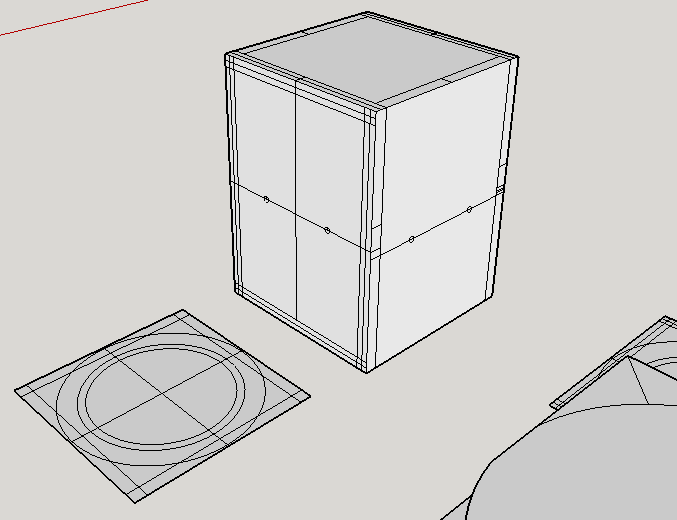
I gave 0.5 cf more, so now it is 2.0 cf, walls are made of 0.5 x 2 glued mdf. I am pointing this thing to be a Mr though guy, designed for big potency. i don't have too much theory in my head related to sealed enclosures, but I supposed that good sealed enclosure should be as solid and though as possible, in order to offer the real potencial that sealed enclosures can give.
Attachments
Last edited:
oh come on, a big holey brace is just the ticket !
Here's one I made earlier 😀
Holey brace! Yay! Haven't heard that in a while. Wheres Dave?
Let's say you have a good quality woofer driver that resonates at 25 Hz. In a 6 cu ft box, that might be forced up to 35 Hz and a bit of a bubble around that region and tapering off mildly below. That would be a very good bass for anything but earthquake movies and all your friends will say it is great.
But in the sort of 1.5 cu ft small box like yours that seems to be recommended by many sim users and Parts Express, it might be forced up to maybe 50, no nice bubble, and tapering off below. Not a very profound woofer although for most music pretty OK. All your friends will say, "Gosh, a nice tight bass. Pity it doesn't go real low."
Ben
Yeah, this isn't how sealed boxes work. The LARGER box will have a LOWER qtc with NO BUBBLE (assuming bubble means a high q peak in response). The SMALLER box will have a HIGHER qtc WITH A BUBBLE (high qtc peak in response).
And since you can eq you can have any qtc and frequency response curve you want, which means these issues are not that important.
More important is sizing the box properly so you can use up your usable excursion without a huge amount of power, thus keeping amp size requirements to a minimum and pushing thermal issues like power compression and thermal failure back. In that regard bigger is better, but the bigger box won't have the "bubble" in response that the smaller box will have unless it's a super high qts driver. In that case it might have a small "bubble" in a large box and a huge "bubble" in a small box.
I use lots of holey braces. They are typically 30-40% holes. Besides bracing the box, a prime purpose is to distribute driver energy to panels other than the baffle. I purposely do not put them at the centre of a panel.
MDF is a lousy material for speaker boxes, especially subwoofers. You want something stiffer than MDF, 18mm quality ply is stiffer than 1" MDF and considerably lighter (a good thing, and as a side effect your back will thank you.
My subwoofers each use a pair of 10" push-push in a well-braced enclosure made of 15mm BB. Braces run in the long direction and are placed just off centre.
Stressed threaded rods are a valid alternative. Tighten them to create an inward stress on the box. You can actually tune the box with different tightnesses.
dave
MDF is a lousy material for speaker boxes, especially subwoofers. You want something stiffer than MDF, 18mm quality ply is stiffer than 1" MDF and considerably lighter (a good thing, and as a side effect your back will thank you.
My subwoofers each use a pair of 10" push-push in a well-braced enclosure made of 15mm BB. Braces run in the long direction and are placed just off centre.
Stressed threaded rods are a valid alternative. Tighten them to create an inward stress on the box. You can actually tune the box with different tightnesses.
dave
Still better than many other materials.MDF is a lousy material for speaker boxes, especially subwoofers.
dave
MDF is a lousy material for speaker boxes, especially subwoofers. You want something stiffer than MDF, 18mm quality ply is stiffer than
😛 MDF is the most suitable material for speakers/subs, because its high fiber density (and very cheap price), the only problem I found, is that you should not join the pieces using screws, because it can easily split in the edges, that can be easily solved using lots of glue and box joints or dowels instead. I am working in a sub that uses 3/4 MDF and 2x2 (1.5x1.5" actually) pine wood in every corner, so every MDF face is screwed onto the 2x2, it will add extra weight, but also make a super strong subwoofer box.
Last edited:
😛 MDF is the most suitable material for speakers/subs, because its high fiber density (and very cheap price)
eeerrrmmmmm 😕 MDF is the acronym for Medium Density Fibreboard. Its nothing like high density. For example it tears/splits easily along it length just from screws, as you said needs battening and soaks up water like a sponge..... It is not all that dense but is heavy.
All of which is a perfect recipe for storing and later farting out energy from the sub.
And as for 'very cheap price' being a sign of quality.....🙄
The most important aspect of a subwoofer box is that it has to be stiff. Flexing of the walls must be limited as much as possible. Reinforcing the edges / corners does not help as those areas are stiff already; the compliant parts are the large surfaces. Connecting opposing walls (cross bracing) is more effective.I am working in a sub that uses 3/4 MDF and 2x2 (1.5x1.5" actually) pine wood in every corner, so every MDF face is screwed onto the 2x2, it will add extra weight, but also make a super strong subwoofer box.
eeerrrmmmmm 😕 MDF is the acronym for Medium Density Fibreboard. Its nothing like high density. For example it tears/splits easily along it length just from screws, as you said needs battening and soaks up water like a sponge..... It is not all that dense but is heavy.
All of which is a perfect recipe for storing and later farting out energy from the sub.
And as for 'very cheap price' being a sign of quality.....🙄
I knew that, but as I know, it's density higher compared to for example, plywood, particulate or pinewood. If worried about moisture, you can varnish it or using water proof glue when gluing the carpet.onto.
I knew that, but as I know, it's density higher compared to for example, plywood
Why is density better for building an enclosure?
The ideal enclosure doesn't store energy and/or vibrate from the driver's energy. The stiffer the better, especially in the bass/sub bass region
MDF and particle board are easy to machine and cheap. That is why it is used in home speakers. If it gets wet, it turns to mush. If you drop it, it fractures.
Plywood is used in pro speakers because it doesn't have those problems, and is stiffer, lighter and stronger than composite wood products.
No matter what you use, you need to brace it.
IMO, the average DIYer turned away from plywood because they were using CDX and cutting it with cheap (and dull?) circular saw blades and getting splinters all over.
Plywood is used in pro speakers because it doesn't have those problems, and is stiffer, lighter and stronger than composite wood products.
No matter what you use, you need to brace it.
IMO, the average DIYer turned away from plywood because they were using CDX and cutting it with cheap (and dull?) circular saw blades and getting splinters all over.
😛 MDF is the most suitable material for speakers/subs, because its high fiber density (and very cheap price)
You are welcome to keep preserving the myth.
If you have 2 materials of the same density the lighter one is better. It takes about 1.25" of MDF to be as stiff as 18mm quality ply.
dave
I have used "spectacle braces", but I like your "5 hole brace" just as much.
I would make the holes much bigger.
The stiffening effect with bigger holes will be adequate.
If you glue and screw into the brace edge from the outside, the brace works in both compression and tension. You NEED strength/stiffness in BOTH directions.
A rod across the box works well in compression if the stresses on the ends are not too high.
But these compression rods are very poor in tension. I would never use a rod, unless I could engineer in adequate tension capability.
I would make the holes much bigger.
The stiffening effect with bigger holes will be adequate.
If you glue and screw into the brace edge from the outside, the brace works in both compression and tension. You NEED strength/stiffness in BOTH directions.
A rod across the box works well in compression if the stresses on the ends are not too high.
But these compression rods are very poor in tension. I would never use a rod, unless I could engineer in adequate tension capability.
Stiffness and strength are two different things. For a subwoofer you need stiffness. Strains are small, so the stiffness is constant; it does not depend on whether the rod is loaded in compression or tension.
Yield strength is not relevant for subwoofers, I have never seen a box get damaged by the air pressure of a woofer.
Yield strength is not relevant for subwoofers, I have never seen a box get damaged by the air pressure of a woofer.
Last edited:
- Status
- Not open for further replies.
- Home
- Loudspeakers
- Subwoofers
- Five hole bracing for sealed enclosure.
